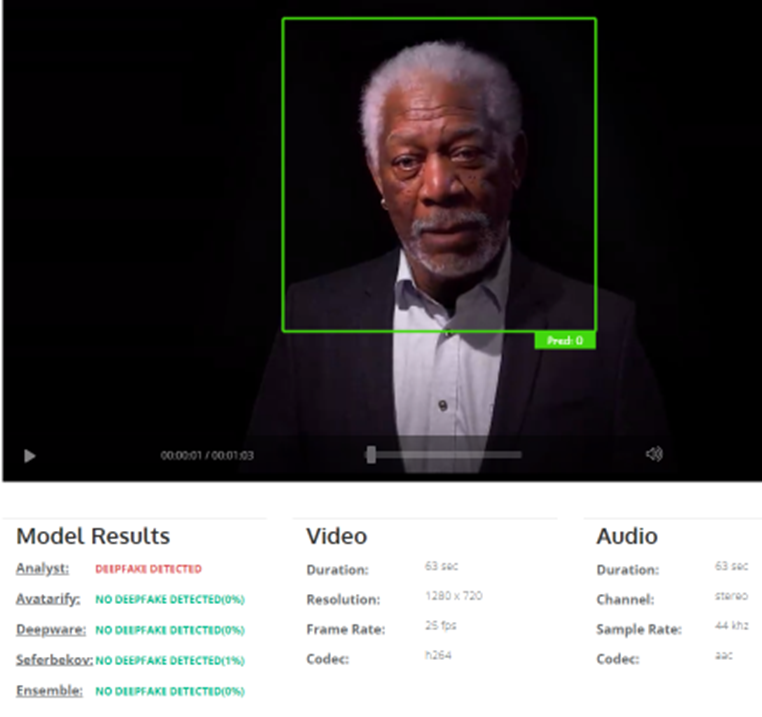Generative AI has proven to be very effective in supporting a person’s everyday life but also in professional life by making vast amounts of knowledge easily digestible and summarized, e.g. with ChatGPT. Besides the known grave dangers like algorithmic bias, lack of transparency and accountability, Deepfakes have been addressed less lately even though there have been very realistic ones like with Morgan Freeman that created a large commotion.
A lot of research has focused on the detection of Deepfakes, with a few websites freely accessible online. Testing out the Deepware detector with a (from human eye perspective) worse deepfake and the well-known Morgan Freeman, the difference in quality is immediately visible:


The deepfake with Elon Musk (Deepware, 2023) is recognized with a high confidence with just one model, while for the deepfake of Morgan Freeman (Deepware, 2023) 5 models are used for detection with only one recognizing it as a deepfake.
Through the evolution of easily accessible Generative Adversarial Networks (GANs) deepfakes often are created with the intention to deceive or to spread misinformation and possibly conduct financial frauds. Their largest influence lies in social media as audio-visual content is most easily spread on these platforms. This could lead to an “infocalypse” (Westerlund, 2019), which would mean that people could only trust their own close social network including friends and family that reinforce the already existing beliefs. Deepfakes that align with the own view even though fake would seem more realistic.
Deepfake videos in particular can be categorized according to into the types i) face-swap, ii) lip-synching, iii) puppet-master, iv) face synthesis and v) audio-only (Masood, 2022) .
In this experiment, I tried to create a deepfake of Donald Trump stating something that he usually would not do. For this, first an audio-only deepfake is created and then using lip-synching matched with an image to create a video.
First, using ChatGPT I phrased a statement that would be unusual for Donald Trump to say.

Afterwards, I explored many different platforms and options to create Donald Trumps voice. One option was to train a TTS (Text-to-speech) voice cloner (Vocloner, 2023) with some audio data found on Kaggle.

Result:
The result was not very convincing, which is why other tools were explored. Fineshare, also a free voice changer website resulted in a poor audio as well. Speechify which is a common tool required a premium subscription for cloning voices that are not recorded by oneself.
Lastly, I used the website FakeYou and found a TTS model pre-trained (FakeYou, 2023) to generate the audio, which resulted in a much better audio. This shows that a more sophisticated and pre-trained model allows for better Deepfakes. With the lip sync function (FakeYou, 2023) an image and the audio of Donald Trump is merged to create a Deepfake.

This free Deepfake detector (Deepware, 2023) did not manage to flag this video as a Deepfake. This shows that detection is still a large problem, although Deepfake detection ideally should be integrated into any social media content post. Only this way I can see how social media is prevented from being flooded with Deepfakes. Having at least a system in place that can show the confidence with which a video is or is not identified as a Deepfake would help a lot, so that users are more aware of the informational value of the content. Social media platforms in context of AI Ethics must bear responsibility to protect the users from misinformation.
Finally, even though Deepfakes are mostly associated negatively, there are many constructive uses. One could be creating personalized and engaging content for Marketing purposes, depending on the user’s data and preferences different influencers can be used to endorse a product specifically for the viewer. It will be easier to create advertising campaigns without the influencers being present and ready. This even has the potential to disrupt how Marketing is done, as this is much more flexible, user-oriented, and possibly cheaper.
Where do you see opportunities for Deepfake? What do you think about its potential impact on social media and what do you think needs to happen to prevent malicious spread and use of Deepfakes?
References
Deepware. (2023). Retrieved from https://scanner.deepware.ai/result/edd37447f779cfc58f48b545f663184d3f6f21ef-1589885916/
Deepware. (2023). Retrieved from https://scanner.deepware.ai/result/2a6115c760da36ee44d757d9105eb1ba4fd66b9f-1629834054/
Deepware. (2023). Retrieved from https://scanner.deepware.ai/result/c53071331497a1da41e8a2b30506342a476c666d-1696428314/?
FakeYou. (2023). Retrieved from https://fakeyou.com/tts/TM:03690khwpsbz
FakeYou. (2023). Retrieved from https://fakeyou.com/face-animation
Masood, M. (2022). Retrieved from https://link.springer.com/article/10.1007/s10489-022-03766-z
Vocloner. (2023). Retrieved from https://vocloner.com/
Westerlund, M. (2019). Retrieved from https://timreview.ca/sites/default/files/article_PDF/TIMReview_November2019%20-%20D%20-%20Final.pdf

